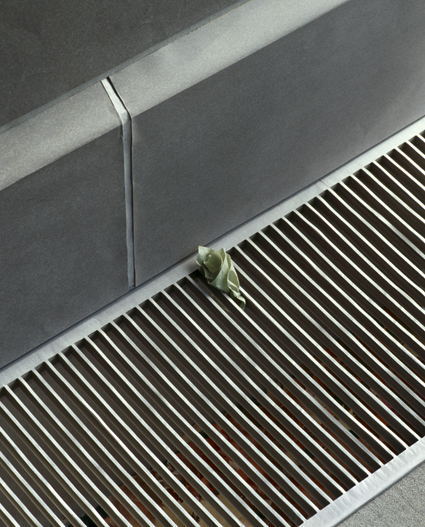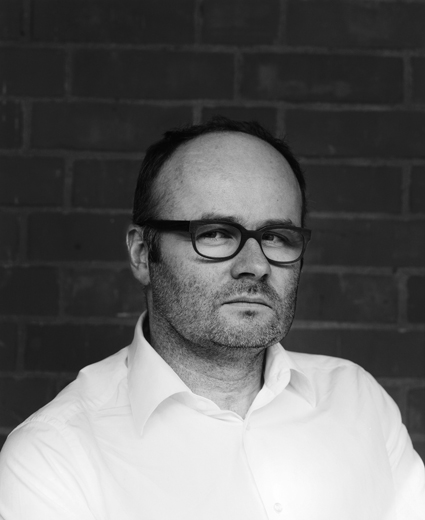the deceptive eye: the world reappraised
keith gallasch: interview, artist, thomas demand

Thomas Demand, Daily #7, 2008
© Thomas Demand, VG Bild-Kunst, Bonn/Viscopy, Sydney, Courtesy Matthew Marks Gallery New York, Esther Schipper, Gallery Berlin and Sprueth Magers Berlin
Thomas Demand, Daily #7, 2008
IN BERLIN IN 2009 I ENCOUNTERED THE WORK OF AN ARTIST NEW TO ME, BERLIN-BASED THOMAS DEMAND. THE WHOLE GROUND FLOOR OF THE NEUE NATIONALGALERIE IN POTSDAMER PLATZ WAS OCCUPIED OR, RATHER, TRANSFORMED BY AN EXHIBITION CURIOUSLY TITLED NATIONALGALERIE.
Hanging against ceiling to floor curtaining chosen by Demand, large, framed artworks were at first glance puzzling. Were they paintings or photographs? Photographs. But of actual objects or meticulously constructed artefacts as small folds and creases slowly registered? Timber and glass cases exhibited open copies of the book that was part of the exhibition, revealing enigmatic texts created by writer Botho Strauss and enhancing the sense of mystery and perceptual misdirection inherent in the exhibition.
Demand’s photographs, often inspired by found images (he keeps an archive of them), reproduce the everyday (houses, garages, bathrooms, kitchen implements, lawns, buildings, a pipe organ even) as life-size sculptures in paper and card, eerily stripped of surplus detail and commercial branding, getting down to some kind of worrying essence. But these images (transmuted from 2D photograph to 3D sculpture and then to photograph again) are not without their connotations. Some, as reviews and essays about the work reveal, are historical evocations with political intent. The image of a wrecked room reproduces the site of the attempted assassination of Adolf Hitler; another recalls the damage wrought in an office by former East Germans attempting to seize their Stasi records. In a 2004 work Demand reproduced the kitchen of the house in which Saddam Hussein had hidden. In 2008 he was commissioned by the New York Times to make a suite of five images of the White House Oval Office.
Humans do not appear in these artworks, but what they make and their effects are strongly felt. In another work (Grotte, 2007), Demand has precisely reproduced nature—an enormous limestone cave using 36 tons of grey cardboard. Demand showed photographs, drawings and plans from the two-year making process but never displayed the finished model which was, as ever with his constructions, destroyed once photographed.
In Sydney, courtesy of the Kaldor Public Art Project, Demand will exhibit The Dailies, a site-specific installation using the accommodation suites that constitute the first floor of the historic Commercial Travellers’ Association in the MLC Building, designed by Harry Seidler, in Martin Place. The public will be able to visit this part of the building for the first time to view Demand’s installation from March 23 to April 22. It will be fascinating to see what Demand makes of this space within an iconic modernist building with its mushroom-like shape. I recently conducted an email interview with the artist.

Thomas Demand
photo Albrect Fuchs
Thomas Demand
When I first saw your work it surprised me, like most viewers, serially. First I thought I was seeing large neo-realist paintings suggestive of photography. I then realised I was looking at photographs of actual objects and spaces, but looking again I sensed a certain abstraction—objects and places were shorn of apparently extraneous detail. Then I noticed that the quality of the surfaces suggested card and paper and folding. I knew then I was looking at and relishing a construction. How did you arrive at this approach that plays with audience perception in such an engaging but disturbing way? What drove you to it?
I started doing these small sculptures out of the cheapest and most ephemeral material I could think of: paper, card and plastic foils. I was at the time surrounded by co-students who would do bronze and plastic sculptures, very time consuming, pricey in the making and this didn’t seem right to me as a beginner who had penty of ideas, too little time and being not so concerned about the afterlife of my efforts.
So after being occupied for a couple of years with making those objects and dumping them when I ran out of storage space at the Academy (in Dusseldorf) my professor pointed out that I had no record of what I did, and I did a lot. So I tried to document them, but not surprisingly without any training in photography it was disappointing not to recognise what I liked about the object I made in the first place: its minimal vocabulary, its fragility and timelessness. I knew that was a basic problem, but nevertheless I wanted to solve it. So I was looking for the most common way of displaying an object in daily life and that seemed to be catalogues, or cheapish adverts. Also I wanted geometry in my reproduction which would be less distorting, more how you would draw something. At that point I didn’t have a clue about technical view cameras, tilts and swings or any other fine tricks. So I made two objects, one as an object and one secondary which would compensate for the unwanted effects the photography had on my effort. Both—the catalogue look and the sculpting—were leading away from what someone else would consider a documentation.
Your work traverses and integrates a number of forms: architecture, sculpture, photography, but in the end the photograph appears to take precedence. However, you have described yourself not as a photographer but as a conceptual artist. But what is it about photography that it finally constitutes the artwork? [Not only that but your commitment to certain photographic processes as with dye transfer.]
I think photography is mainly interesting as a great commonplace. It’s in fact a global agreement how to recognise the world in a representation. Everyone knows how it works, how the apparati produce an image and thus it’s a pretty important part of our experience and understanding what’s around us. So in that way it doesn’t matter if it’s dye transfer, polaroid or digital. More importantly though, with the social aspects of the internet coming into more importance, we also learned to ask ourselves who is sending us the image, who is the author, and we do that to a much greater extent than say 10 years ago (all this is pretty new anyway, only in late 1995 the net was capable of sending images, we tend to forget what a major development that was—just 16 years ago). So for an artist, this is an important field for studies, like the world outside was for the Romantic landscape painters of the 18th century or the city was for expressionism. And to come back to your question: only at US-immigration and in interviews I have to define whether I am a photographer or not. I consider myself an artist.
I gather that once you’ve photographed your sculptural creations you destroy them. It’s a potent gesture (storage issues aside). Why destroy such painstaking work, which I assume you enjoy creating? Is there a particular pleasure in the act of destruction over and above an aesthetic and possibly political motivation?
No, no particular pleasure, but it is a relief to have an open empty space, it’s more inspiring than having a cluttered, stuffed studio with lots of unresolved leftovers—at least for me.
Your motivation in Nationalgalerie appears to be at times political, if not literally, although, unlike me, a German viewer would doubtless recognise the significance of certain images more often. What is it that triggers your desire to create a particular image? Is there a variety of impulses?
I guess many, but frankly if I would know what makes a good image, I would probably stop looking for them. It’s sometimes themes, conceptual questions I chew on for years or I simply recognise something I wanted to do since long ago in an image which I would have never dreamt of.
You build three-dimensional models of things you have seen, including events recorded in photographs. Why life-size? I read somewhere that you said you hate building maquettes, that you don’t have the patience, so I was interested to see that for Nottingham Contemporary this year you’ve photographed 12 architectural models of buildings by the great Los Angeles architect John Lautner. What was the appeal?
It’s a study project and I didn’t build the models, so my hate for the diminished scale is still intact. They are still paper, still models, I still photograph them, but in this case they aren’t mine. Also, it enabled me to ponder elements I haven’t employed in my previous work, such as decay, writing, damage and materiality. But they are leaning towards abstract painting much more than they celebrate John Lautner. You wouldn’t be able to recognize one single building from the images.
After wandering about Nationalgalerie for more than an hour I became increasingly alert to the staging of the exhibition, that the way the photographs were hung against curtains (in a wall-less gallery space), the maze-like effect of travelling through the show, and the museum-like placement in timber and glass cabinets of the open pages of the catalogue bearing Botho Strauss’ text as they related to a nearby photograph, all had a dramaturgical impact. I was inside an installation. So it’s very interesting that The Dailies, it seems, will be even more palpably an installation, a site-specific one responsive to the Commercial Travellers’ Association in the MLC building in Sydney’s Martin Place. How did this come about?
Like you I was wandering around in Sydney and came by that rather quirky building. I asked myself what’s inside and no one really could tell me, so I smuggled myself in and saw the circular layout, which immediately won me over. The arching is done with nervi [the reinforced concrete designs pioneered by engineer and architect Pier Luigi Nervi who collaborated with Seidler. Eds] and the repetitiveness of the rooms is great for a show like this. So with a few subtle adjustments and the invitation to Mr Begley and Ms Prada to make this more complex than art in a hotel, I do hope it will become a rather special experience.
I read in an interview that you like working alone, however your work is significantly collaborative—whether with Botho Strauss or the architect Caruso St John or the curator of Nationalgalerie, or in The Dailies in Sydney with Miuccia Prada, who will create a scent for the installation, and US writer Louis Begley, who will provide a short story. How do you choose and work with your collaborators?
Just intuition. I looked outside the window and saw a Prada shop, so I thought it would be nice if this hotel, literally kept without changes since 1974, would smell like a Prada shop. And then you take it from there (by the way they don’t have a scent in those shops, as the leather smells so strong it’s not necessary). And Begley, I just knew he was a very, very successful and important lawyer as much as an unforgettable writer, so I thought this place might resonate well with him.
Without wishing to pre-empt the audience experience of The Dailies, what is it that you wish to achieve by engaging with this Australian modernist space?
You tell me. I made the art already.
Kaldor Public Art Projects, Thomas Demand, The Dailies, Commercial Travellers’ Association?MLC Centre, Martin Place, Sydney, March 23- April 22
Special Public Lectures: Sydney – Domain Theatre AGNSW, March 23, 6pm; Melbourne – Clemenger BBDO Auditorium, NGV, March 24, 3pm
RealTime issue #107 Feb-March 2012 pg. 44-45






